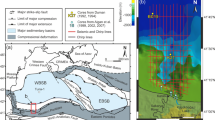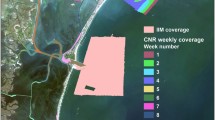Abstract
Multibeam echo-sounder (MBES), sub-bottom profiler, singlebeam tracks and public-domain bathymetry geophysical datasets were analyzed in a Geographic Information System (GIS) for accuracy assessment and further used to update the previous map (Curray et al. Mar Pet Geol 19: 1191–1223, 2003) of submarine channel-levee systems in the eastern Bengal Fan near the Andaman region. Comparative analysis of singlebeam with MBES indicated 2.8 % of root-mean-square difference in bathymetry, and could clearly bring out distinct submarine channel profiles. The channel map revealed that the previously named E6 [updated as E7(1a)] and E7 [updated as E7(1b)] channels emanate from the middle and lower Bengal Fan, respectively and merge together at 91.28°E, 10.64°N where they form a second order channel [E7(2)] that flows southward along the east of Ninety-east Ridge. Similarly, two first order channels [E6(1a) and E6(1b)] emanate from the lower Bengal Fan which merge together at 88.78°E, 06.92°N to form a second order channel [E6(2)] that flows along the west of Ninety-east Ridge towards the equator. This channel was previously thought to be linked to the middle Bengal Fan. High-resolution MBES tracks over the channel shows extensive meandering patterns with the channel gently deepening and widening towards south. Variations in the morphology and stratigraphy indicate that the E7 channel is characterized by a curvilinear course, with higher observed sinuosity wherever gradient decreases.





Similar content being viewed by others
References
Abreu V, Sullivan M, Pirmez C, Mohrig D (2003) Lateral accretion packages (LAP’s): an important reservoir element in deep water sinuous channels. Mar Pet Geol 20:631–648
Amante C, Eakins BW (2009) ETOPO1 1 Arc-minute global relief model: procedures, data sources and analysis. NOAA Technical Memorandum NESDIS NGDC-24, 19 pp
Bastia R, Radhakrishna M, Das S, Kale AS, Octavian C (2010) Delineation of the 85°E ridge and its structure in the Mahanadi Offshore Basin, Eastern Continental Margin of India (ECMI), from seismic reflection imaging. Mar Pet Geol 27:1841–1848
Baztan J, Berné S, Olivet JL, Rabineau M, Aslanian D, Gaudin M, Réhault JP, Canals M (2005) Axial incision: the key to understand submarine canyon evolution (in the western Gulf of Lion). Mar Pet Geol 22(6–7):805–826
Centenary Edition of the GEBCO Digital Atlas (2008) User Guide to the GEBCO One Minute Grid, available at http://www.gebco.net/data_and_products/gridded_bathymetry_data/
Curray JR (1994) Sediment volume and mass beneath the bay of Bengal. Earth Planet Sci Lett 125:371–383
Curray JR, Moore DG (1971) Growth of the Bengal deep-sea fan and denudation in the Himalayas. Geol Soc Am Bull 82:563–572
Curray JR, Moore GD (1974) Sedimentary and tectonic processes in the Bengal deep sea fan and geosyncline. In: Burke CA, Drake CL (eds) The geology of continental margin. Springer, New York, pp 617–627
Curray JR, Emmel FJ, Moore DG (2003) The Bengal fan: morphology, geometry, stratigraphy, history and processes. Mar Pet Geol 19:1191–1223
Damuth JE, Kolla V, Flood RD, Kowsmann RO, Monteiro MC, Gorini MA, Palma JJC, Belderson RH (1983) Distributary channel meandering and bifurcation patterns on Amazon deep-sea fan as revealed by long-range side-scan sonar (GLORIA). Geology 11:94–98
Damuth JE, Flood RD, Kowsmann RO, Belderson RH, Gorini MA (1988) Anatomy and growth pattern of Amazon deep-sea fan as revealed by long-range side-scan sonar (GLORIA) and high resolution seismic studies. Bull Am Assoc Pet Geol 72:885–911
Dennielou B, Huchon C, Beaudouin C, Berné S (2006) Vertical grain size variability within a turbidite levee: autocyclicity or allocyclicity? A case study from the Rhô ne neofan, Gulf of Lions, Western Mediterranean. Mar Geol 234:191–213
Emmel FJ, Curray JR (1985) Bengal fan, Indian ocean. In: Bouma AH, Normark WR, Barnes NE (eds) Submarine fans and related turbidite systems. Springer, New York, pp 107–112
Fairbanks RG (1989) A 17,000-year glacio-eustatic sea level record: influence of glacial melt waters rates on the Younger Dryas event and deep-ocean circulation. Nature 298:841–844
Flood RD, Piper DJW, Klaus A, Peterson LC (1997) Proceedings of the ODP, Scientific Results, 155. College Station, TX (Ocean Drilling Program)
Hall J (2006) GEBCO centennial special issue charting the secret world of the ocean floor: the GEBCO project 19032003. Mar Geophys Res 27(1):1–5
Hay AE (1987) Turbidity currents and submarine channel formation in Rupert Inlet, British Columbia: 1. Surge observations. J Geophys Res 92:2875–2881
Heezen BC, Ewing M (1952) Turbidity currents and submarine slumps, and the Grand Banks earthquake. Am J Sci 250:849–873
Hesse R, Khodabakhsh S (1998) Depositional facies of late Pleistocene Heinrich events in the Labrador sea. Geology 26(2):103–106
Hiscott RN, Hall FR, Pirmez C (1997) Turbidity-current overspill from the Amazon channel: texture of the silt/sand load, paleoflow from anisotropy of magnetic susceptibility and implications for flow processes. In: Flood RD, Piper DJW, Klaus A, Peterson LC (eds) Proceedings ODP, Scientific Results 155:53–78
Hubscher C, Spieβ V, Breitzke M, Weber ME (1997) The youngest channel–levee system of the Bengal Fan: results from digital sediment echosounder data. Mar Geol 141:125–145
IHO Standards for Hydrographic Surveys (S-44), Special Publication S-44, 5th edition, February 2008. International Hydrographic Bureau, Monaco
Jena B, Kuriana PJ, Swain D, Tyagi A, Ravindra R (2012a) Prediction of bathymetry from satellite altimeter based gravity in the Arabian Sea: mapping of two unnamed deep seamounts. Int J Appl Earth Obs 16:1–4
Jena B, Swain D, Kumar A (2012b) Investigation of the biophysical processes over the oligotrophic waters of South Indian Ocean subtropical gyre triggered by cyclone Edzani. Int J Appl Earth Obs 18:49–56
Jones MT (1997) The GEBCO digital atlas; a seamless, digital, bathymetric contour chart of the world’s oceans. Hydro Int 1(1):46–47
Kolla V, Kidd RB (1982) Sedimentation and sedimentary processes in the Indian Ocean. In: Nairn AEM, Stehli FG (eds) The ocean basins and margins. New York, p 1–50
Kolla V, Bandyopadhyay A, Gupta P, Mukherjee B, Ramana DV (2012) Morphology and internal structure of a recent upper Bengal fan-valley complex. SEPM Soc Sediment Geol 99:347–369. doi:10.2110/pec.12.99.0347
Kudrass HR, Michels KH, Wiedicke M, Suckow A (1998) Cyclones and tides as feeders of a submarine canyon off Bangladesh. Geology 26(8):715–718
Kudrass HR, Hofmann A, Doose H, Emeis K, Erlenkeuser H (2001) Modulation and amplification of climatic changes in the Northern Hemisphere by the Indian summer monsoon during the past 80 k.y. Geology 29:63–66
Maslin M, Vilela C, Mikkelsen N, Grootes P (2005) Causes of catastrophic sediment failures of the amazon fan. Quat Sci Rev 24:2180–2193
Michels KH, Kudrass HR, Hübscher C, Suckow A, Wiedecke M (1998) The submarine delta of the Ganges–Brahmaputra: cyclone dominated sedimentation patterns. Mar Geol 149:133–154
Middleton GV (1993) Sediment deposition from turbidity currents. Annu Rev Earth Planet Sci 21:89–114
Migeon S, Savoye B, Faugeres JC (2000) Quaternary development of migrating sediment waves in the Var deep-sea fan: distribution, growth pattern and implication for levee evolution. Sediment Geol 133:265–293
Milliman JD, Meade RH (1983) World-wide delivery of river sediment to the oceans. J Geol 91:1–21
Moore DG, Curray JR, Emmel FJ (1976) Large submarine slide (olistostrome) associated with Sunda Arc subduction zone, northeast Indian Ocean. Mar Geol 21:211–226
Normark WR, Hess GR (1980) Quaternary growth patterns of California submarinefans. In: Field ME, Bouma AH, Colburn IP, Douglas RG, Ingle JC (ed), Pacific Coast Paleogeography Symposium 4:201–210
Piper DJW, Normark WR (1983) Turbidite depositional patterns and flow characteristics, Navy submarine fan, California Borderland. Sedimentology 30:681–694
Piper DJW, Shaw J, Skene KI (2007) Stratigraphic and sedimentological evidence for late Wisconsinan sub-glacial outburst floods to Laurentian fan. Palaeogeogr Palaeoclimatol 246(1):101–119
Pirmez C, Flood RD (1995) Morphology and structure of amazon channel. In: Flood RD, Piper DJW, Klaus A et al (eds) Proceedings of the Ocean Drilling Program, Initial Reports, 155. Ocean Drilling Program, College Station, pp 23–45
Pirmez C, Hiscott RN, Kronen JDJ (1997) Sandy turbidite successions at the base of channel-levee systems of the Amazon fan revealed by FMS logs and cores: unravelling the facies architecture of large submarine fans. In: Flood RD, Piper DJW, Klaus A, Peterson LC (ed) Proceedings of the Ocean Drilling Project, Scientific Results 155:7–33
Posamentier HW, Kolla V (2003) Seismic geomorphology and stratigraphy of depositional elements in deep-water settings. J Sediment Res 73:367–388
Roonwal GS, Glasby GP, Chugh R (1997) Mineralogy and geochemistry of surface sediments from the Bengal Fan, Indian ocean. J Asian Earth Sci 15:33–41
Schwenk T, Spieβ V, Hubscher C, Breitzke M (2003) Frequent channel avulsions within the active channel–levee system of the middle Bengal Fan - an exceptional channel–levee development derived from Parasound and Hydrosweep data. Deep-Sea Res II 50:1023–1045
Skene KI, Piper DJW, Hill PS (2002) Quantitative analysis of variations in depositional sequence thickness from submarine channel levees. Sedimentology 49:1411–1430
Smith WHF, Sandwell DT (1997) Global seafloor topography from satellite altimetry and ship depth soundings. Science 277:1957–1962
Stow DAV, Cochran JR, ODP Leg 116 Shipboard Scientific Party (1989) The Bengal fan: some preliminary results from ODP drilling. Geo-Mar Lett 9:1–10
Straub KM, Mohrig D, McElroy B, Buttles J, Pirmez C (2008) Interactions between turbidity currents and topography in aggrading sinuous submarine channels: a laboratory study. Geol Soc Am Bull 120(3):368–385
Subramanian V (1980) Mineralogical input of suspended matters by Indian rivers into the adjacent area of the Indian Ocean. Mar Geol 36:M29–M34
Sylvester Z, Pirmez C, Cantelli A (2011) A model of submarine channel–levee evolution based on channel trajectories: implications for stratigraphic architecture. Mar Pet Geol 30:1–12
Toucanne S, Zaragosi S, Bourillet JF, Naughton F, Cremer M, Eynaud F, Dennielou B (2008) Activity of the turbidite levees of the Celtic–Armorican margin (Bay of Biscay) during the last 30,000 years: imprints of the last European deglaciation and Heinrich events. Mar Geol 247(1–2):84–103
Vail PR, Audemard F, Bowman SA, Eisner PN, Perez-Cruz C (1991) The stratigraphic signatures of tectonics, eustasy and sedimentology—an overview. In: Einsle G, Ricken W, Seilacher A (ed), Cycles and Events in Stratigraphy, Springer-Verlag, New York 617–659
Von Rad U, Tahir M (1997) Late Quaternary sedimentation on the outer Indus shelf and slope (Pakistan): evidence from high-resolution seismic data and coring. Mar Geol 138:193–236
Weber ME, Wiedicke MH, Kudrass HR, Hubscher C, Erlenkeuser H (1997) Active growth of the Bengal Fan during sea-level rise and high-stand. Geology 25:315–318
Wonham JP, Jayr S, Mougamba R, Chuilon P (2000) 3D sedimentary evolution of a canyon fill (Lower Miocene-age) from the Mandorove Formation, offshore Gabon. Mar Pet Geol 17:175–197
Zühlsdorff C, Wien K, Stuut JBW, Henrich R (2007) Late quaternary sedimentation within a submarine channel-levee system offshore Cap Timiris, Mauritania. Mar Geol 240(1–4):217–234
Acknowledgments
The authors are thankful to the Director, National Centre for Antarctic and Ocean Research (NCAOR) and Ministry of Earth Sciences (MoES), Government of India for funding and permission to publish the results. The various institutions like the National Geophysical Data Center (NGDC), British Oceanographic Data Centre (BODC) are acknowledged for making the datasets available through their web sites. We also acknowledge anonymous reviewers for carefully going through the manuscript. This is NCAOR contribution number 06/2016.
Author information
Authors and Affiliations
Corresponding author
Rights and permissions
About this article
Cite this article
Jena, B., Kurian, P.J. & Avinash, K. Morphology of submarine channel-levee systems in the eastern Bay of Bengal near Andaman region. J Coast Conserv 20, 211–220 (2016). https://doi.org/10.1007/s11852-016-0431-2
Received:
Revised:
Accepted:
Published:
Issue Date:
DOI: https://doi.org/10.1007/s11852-016-0431-2




